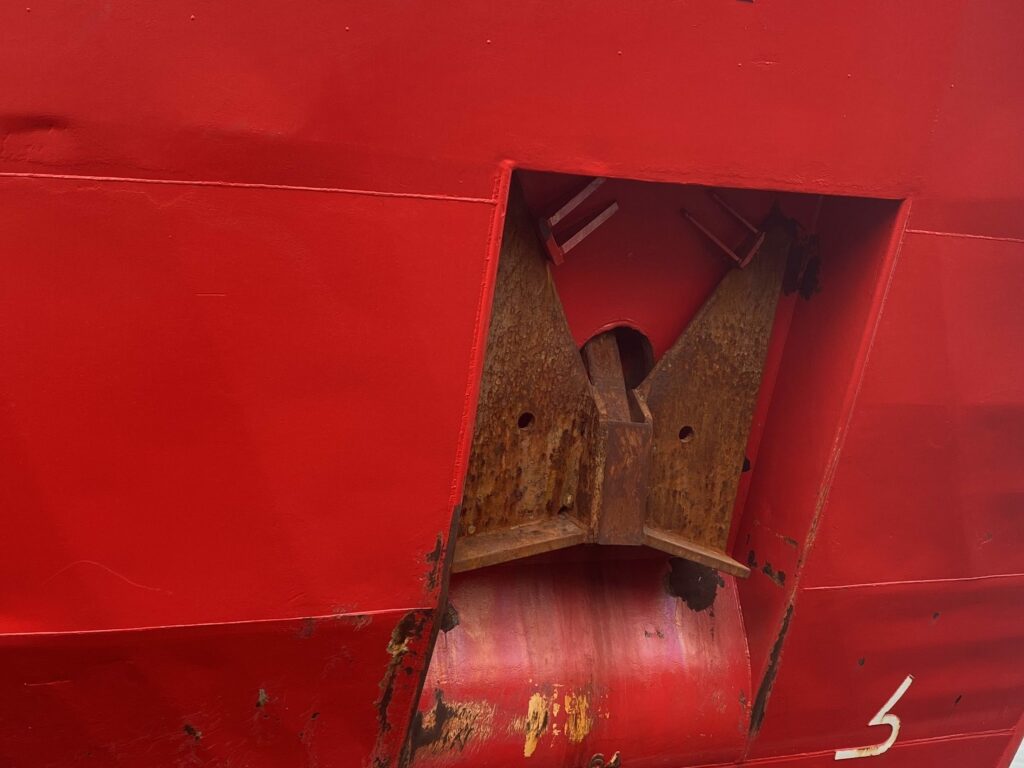The ship’s anchor is important deck equipment used in anchorage or to secure the ship whilst at the port. The bitter end of the chain is connected to the chain locker and the other end is connected to the anchor.
The length of a ship’s anchor chain would depend on the deepest water one’s ship is expected to navigate and drop her anchor. This is done by multiplying the depth of water a minimum of five times and a maximum of eight.

Knowing the depth of water and chain length to be used are keys to a successful anchorage procedure that can prevent the ship from dragging and allowing the anchor to hold properly.
Anchoring In Windy Conditions
Oftentimes, the wind is going to be the biggest concern during anchorage or even at the port as this can directly affect the ship. The key is to anticipate the maximum forecasted wind strength in the area for the duration of your stay.
For pleasure yachts and small boats of ten meters in length, with winds maximum of sixteen knots, and water depth of eight meters, the anchor chain to be used can be from twenty-five to thirty meters. When the wind changes to about force seven, increase the chain to about forty-five meters.
Tide can also be taken into consideration by converting tide height to your ship into a relative wind speed. Differing headwinds and noting the engine rpm can provide accurate wind speed and tidal flow conversion. A shackle is a unit of length used in an anchor chain that is equal to fifteen fathoms or ninety feet. Reading up on fathoms may help you understand better fathom as a measurement unit used on nautical charts and in seamanship.
Different Types Of Ships Anchors
Anchors are important deck equipment for all ships. For through them, vessels are able to hold their place in either the anchorage area or even in port.
Naval architects have an array of options for different types of anchors nowadays in the market. Modern anchors designs are extremely stable, and effective, and are able to easily grip surfaces underwater.
Anchors fulfill their purpose by either using their weight to hold ships/structures in place, clamping onto the seabed or a combination of these two techniques.
Ship anchors are generally made of strong and solid metals which are resistant to corrosion and use galvanization and electroplating for protection. Others use carbon fiber, polymers, or similar materials. These types of anchors have a high strength-to-weight ratio and can handle a significant amount of load, strain, and stress.
However, light-reinforced composite anchors tend to be more expensive than traditional anchors which use the weight of an anchor to aid in holding down ships. None-composite anchors are not only affordable but also easily accessible.
Basic Types Of Ship Anchors
Traditional anchors that are being used by most merchant vessels employ either of the three basic standard designs. These are Admiralty, Fluked, and Stockless designs which are also used by small boats and pleasure crafts.
The basic parts of an anchor include the ring (shackle), shank, flukes, bill, throat and arms, blade, and crown. The admiralty design anchor has two flukes connected to the central shank by arms perpendicular to the main axis. A solid bar is attached to the intersection between the shank and the chain link.
The Admiralty Pattern Anchor
Admiralty design anchors are used towards the ocean floor until one of the flukes clamps on the bottom and settles in. The fluke is forced into the seabed under its weight and the additional force from the stock.
One disadvantage of admiralty anchors is that they can foul up the anchor because the arm is not embedded in the ocean bed.
To correct this, some designs incorporate arms of the anchor that can collapse onto the central shank. In this way, the anchor changes into a single shank and fluke design that can be secured easily and not foul up the anchor when released.
Fluke Anchor
Fluke design anchor on the other hand uses flukes connected to the central arm of the anchor, commonly referred to as the shank. Flukes are used to provide grip and weight to the anchor. This type of anchor is one of the most basic designs that use the weight of the anchor to drive the flukes into the bottom of the ocean.
Fluke anchors are best used for weeds, rocky bottoms, and grassy seabed. They are also ideal for small boats, ideally less than thirty feet. They are easy to store and secure as they are able to fold flat. The key to its holding power lies in its pointed flukes digging into the bottom of the ocean.
Stockless Anchor
Lastly, a stockless ship anchor is designed for ships that may encounter all types of the sea bottoms, as they are able to hold in sand or mud, and in very hard sea bottoms. The crown, arms, and flukes of this anchor are combined into one piece and can pivot and slide slightly on the shank.
The flukes of a stockless anchor are long and heavy which also include projecting shoulders at their base that clamp on the seabed. As the anchor drags, the shoulders force the flukes downward into the bottom of the ocean.
- Sustainable and Luxurious: Discovering Split’s Yachting Paradise – April 26, 2024
- MarineTraffic vs VesselFinder: Which Is Better Vessel Tracking Service? – February 14, 2024
- Port Costs: A Comprehensive Guide to Port Dues and Fees for Cargo Ships – February 12, 2024





Leave a Reply